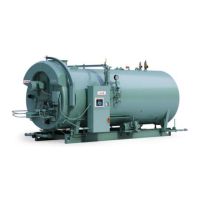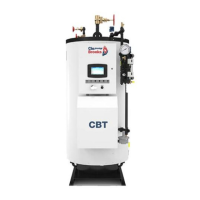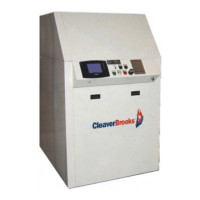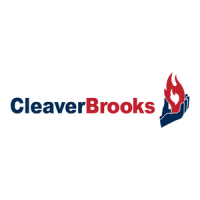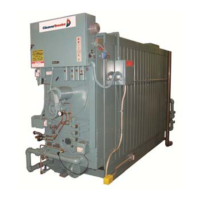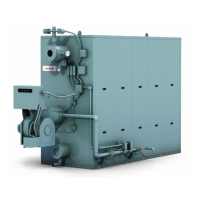750-392
CBEX-DE
4-3
Sequence of Operation
Firing Rate Controls:
The Cleaver-Brooks Hawk boiler control system comprises two primary subsystems: flame supervision/burner
sequencing, and modulation or firing rate control. Upon establishment of main flame, the program relay
(CB780E as standard) relinquishes control to the Hawk modulation controls. Modulated firing is accomplished
by sending Modbus signals from the Hawk controls to the separately driven air, fuel, and FGR actuators.
4.1.1 — Pre-Purge Cycle
When the Burner Switch (BS) is turned ON, and controls in the Limit and Fuel Valve Interlock circuits are closed
and no flame signal is present, the Blower Motor Start circuit is powered, energizing the blower motor starter
(BMS). The load demand light (LDL) turns on. When firing oil, the air compressor motor starter (ACMS; if pro-
vided) is also powered.
At the same time, the air damper actuator will drive the damper to its fully open or high fire position. Opening the
damper allows a flow of purging air through the boiler prior to the ignition cycle.
The High Fire Relay (HFR) will prove that the damper actuator has driven the damper to the open position during
the pre-purge cycle.
The controls wired into the Running Interlock circuit must be closed within 10 seconds after the start sequence.
In the event any of the controls are not closed at this time, or if they subsequently open, the boiler will go into a
safety shutdown.
At the completion of the high fire purge period, the damper actuator will drive the air damper to its low fire posi-
tion.
To assure that the system is in low fire position prior to ignition, the Low Fire Relay (LFR) must be closed to com-
plete the low fire proving circuit. Once the low fire switch is closed, the sequence is allowed to continue.
4.1.2 — Ignition Cycle
NOTE: The ignition trial cannot be started if flame or a flame simulating condition is sensed during the pre-purge
period. A safety shutdown will occur if flame is sensed at this time.
The ignition transformer (IT) and gas pilot valve (GPV) are energized from the appropriate pilot ignition terminal.
The pilot flame must be established and proven by the flame detector (FD) within a 10 second period in order for
the ignition cycle to continue. If for any reason this does not happen, the system will shut down and safety lock-
out will occur.
NOTE: If the main flame does not light, or stay lit, the fuel valve will close. The safety switch will trip to lock out
the control. Refer to flame loss sequence below for description of action.
Components/Controls
• Low Fire Relay (LFR)
• High Fire Relay (HFR)
• Release to Modulate Relay (RMR)
• Air Actuator
• Fuel 1 Actuator
• Fuel 2 Actuator (combination burners)
• FGR Actuator
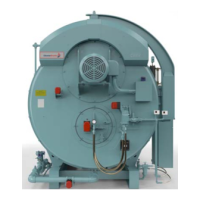
